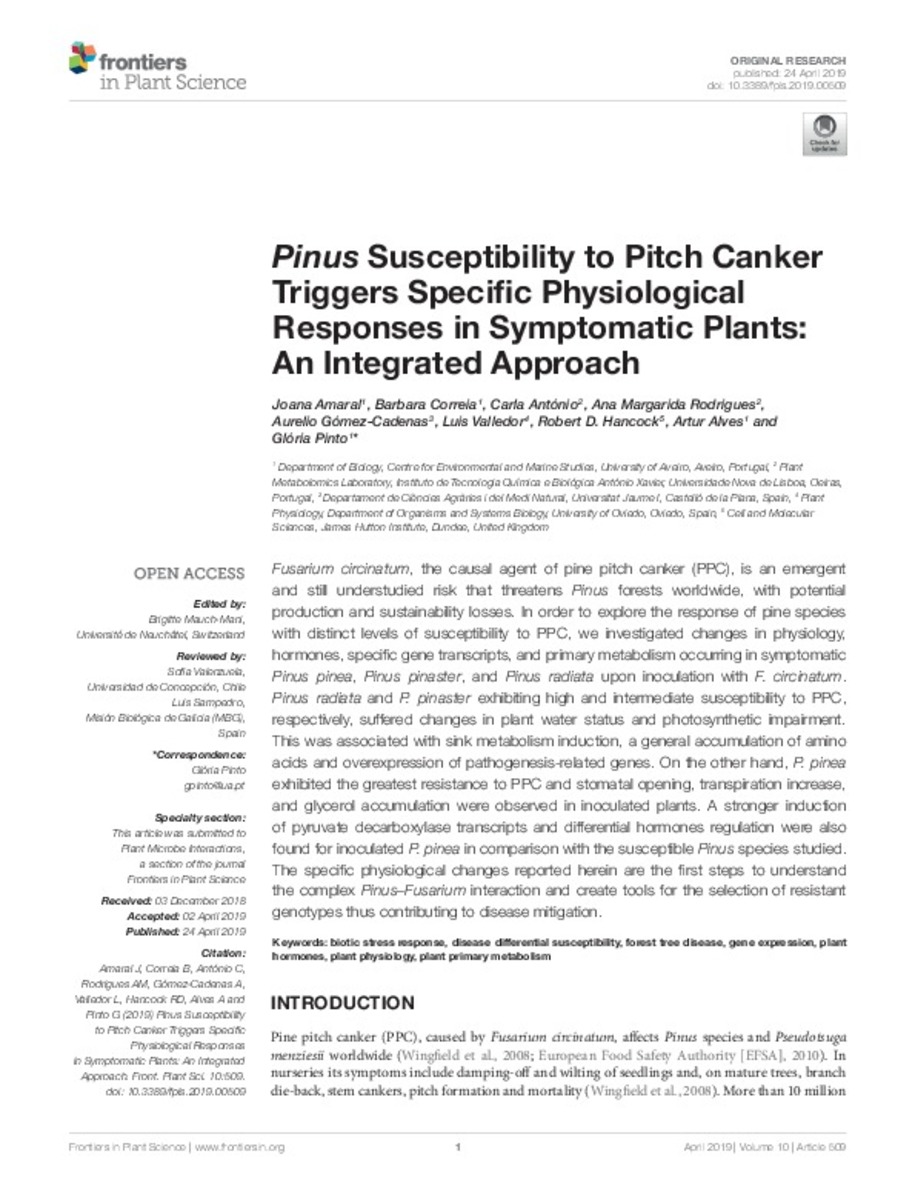Mostrar el registro sencillo del ítem
Pinus Susceptibility to Pitch Canker Triggers Specific Physiological Responses in Symptomatic Plants: An Integrated Approach
| dc.contributor.author | Amaral, Joana | |
| dc.contributor.author | Correia, Barbara | |
| dc.contributor.author | António, Carla | |
| dc.contributor.author | Rodrigues Rebelo, Ana Margarida | |
| dc.contributor.author | Gomez-Cadenas, Aurelio | |
| dc.contributor.author | Valledor, Luis | |
| dc.contributor.author | Hancock, Robert D. | |
| dc.contributor.author | Alves, Artur | |
| dc.contributor.author | Pinto, Glória | |
| dc.date.accessioned | 2019-06-06T09:54:54Z | |
| dc.date.available | 2019-06-06T09:54:54Z | |
| dc.date.issued | 2019-04-24 | |
| dc.identifier.uri | http://hdl.handle.net/10234/182707 | |
| dc.description.abstract | Fusarium circinatum, the causal agent of pine pitch canker (PPC), is an emergent and still understudied risk that threatens Pinus forests worldwide, with potential production and sustainability losses. In order to explore the response of pine species with distinct levels of susceptibility to PPC, we investigated changes in physiology, hormones, specific gene transcripts, and primary metabolism occurring in symptomatic Pinus pinea, Pinus pinaster, and Pinus radiata upon inoculation with F. circinatum. Pinus radiata and P. pinaster exhibiting high and intermediate susceptibility to PPC, respectively, suffered changes in plant water status and photosynthetic impairment. This was associated with sink metabolism induction, a general accumulation of amino acids and overexpression of pathogenesis-related genes. On the other hand, P. pinea exhibited the greatest resistance to PPC and stomatal opening, transpiration increase, and glycerol accumulation were observed in inoculated plants. A stronger induction of pyruvate decarboxylase transcripts and differential hormones regulation were also found for inoculated P. pinea in comparison with the susceptible Pinus species studied. The specific physiological changes reported herein are the first steps to understand the complex Pinus–Fusarium interaction and create tools for the selection of resistant genotypes thus contributing to disease mitigation. | ca_CA |
| dc.format.extent | 16 p. | ca_CA |
| dc.format.mimetype | application/pdf | ca_CA |
| dc.language.iso | eng | ca_CA |
| dc.publisher | Frontiers Media | ca_CA |
| dc.relation.isPartOf | Frontiers in Plant Science (2019), v. 10 | ca_CA |
| dc.rights | Atribución 4.0 Internacional | * |
| dc.rights.uri | http://creativecommons.org/licenses/by-sa/4.0/ | * |
| dc.subject | Biotic stress response | ca_CA |
| dc.subject | Disease differential susceptibility | ca_CA |
| dc.subject | Forest tree disease | ca_CA |
| dc.subject | Gene expression | ca_CA |
| dc.subject | Plant hormones | ca_CA |
| dc.subject | Plant physiology | ca_CA |
| dc.subject | Plant primary metabolism | ca_CA |
| dc.title | Pinus Susceptibility to Pitch Canker Triggers Specific Physiological Responses in Symptomatic Plants: An Integrated Approach | ca_CA |
| dc.type | info:eu-repo/semantics/article | ca_CA |
| dc.identifier.doi | https://doi.org/10.3389/fpls.2019.00509 | |
| dc.rights.accessRights | info:eu-repo/semantics/openAccess | ca_CA |
| dc.relation.publisherVersion | https://www.frontiersin.org/articles/10.3389/fpls.2019.00509/full | ca_CA |
| dc.contributor.funder | 1) URGENTpine (PTDC/AGRFOR/2768/2014) funded by FCT – Fundação para a Ciência e a Tecnologia, I.P., through national funds, and the co-funding by the FEDER (POCI-01-0145-FEDER-016785), within the PT2020 Partnership Agreement and Compete 2020; 2) CESAM (UID/AMB/50017/2019), to FCT/MCTES through national funds; 3) (SFRH/BD/120967/2016): 4) (PD/BD/114417/2016); 5) (IF/00376/2012/CP0165/CT0003); 6) ITQB NOVA R&D GREEN-it ‘Bioresources for Sustainability’ (UID/Multi/04551/2013); 7) International Ph.D. Programme ‘Plants for Life’ (PD/00035/2013). | |
| dc.type.version | info:eu-repo/semantics/publishedVersion | ca_CA |
Ficheros en el ítem
Este ítem aparece en la(s) siguiente(s) colección(ones)
-
CAMN_Articles [566]








